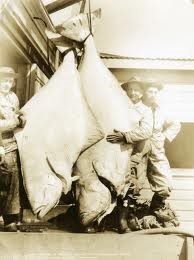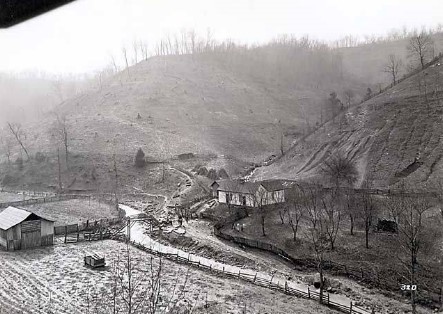|
A reader of this web site recently expressed his frustration about
older sighting reports that we include in the 'Recent Reports' page.
I was going to write back explaining about the "Halibut Effect",
but then realized there should be a special web page about the concept.
 When you look at the BFRO's page of "Sighting Reports Recently Added" (i.e. not "Recent Reports") keep the Halibut Effect in mind. In other words, pay attention to the older reports that have been recently received and made public. Pay attention to the locations mentioned. Those locations are almost as important as the locations of recent sightings, especially if the location hasn't changed much since the year of the sighting. When you look at the BFRO's page of "Sighting Reports Recently Added" (i.e. not "Recent Reports") keep the Halibut Effect in mind. In other words, pay attention to the older reports that have been recently received and made public. Pay attention to the locations mentioned. Those locations are almost as important as the locations of recent sightings, especially if the location hasn't changed much since the year of the sighting.
The
term "Halibut Effect" was coined by bigfoot researcher
(and avid fisherman) Cliff Barackman to describe how large halibut
can be found in areas where they were once caught frequently, but
were thought to have been eradicated from over-fishing. As Cliff
describes it, "You can go to a fishing spot where loads of
huge halibut were reeled in decades ago, and pretty well fished-out
decades ago, and you can catch huge halibut there today".
In other words, marine habitats with all the right factors and
ingredients which allowed halibut to grow very large decades
ago, would eventually attract more halibut and allow them
to grow very large again.
It's a good analogy for bigfoot sighting locations. If the natural
character of an area has not changed much since the last credible
sighting there, or if the area is even more forested nowadays, then
there's a good chance that bigfoots will still use the area from
time to time. We can make guesses about some of the factors and
ingredients (i.e. abundant protein sources; difficult terrain with
thick forest cover; very quiet, wind-protected hollows with numerous,
shrouded escape routes; mineralized springs, etc.), but it may take
many more decades to know all of them.
Q: Why do some people wait years to report their sightings?
A: Many people do not report a sighting for years for various reasons. Most often the reason is because reporting the incident was not a priority at the time, and the witness did not know where to report the sighting until he/she started looking up information online years later.
For many years many amateur bigfoot researchers have said that bigfoots
will apparently return to areas where they had been spotted many
years before. Others who follow local reports will say there seems
to be a cycle for when they inhabit a given area and then move on.
With that in mind, many BFRO expeditions over the years have targetted
areas where there had been at least one very credible sighting (among
a cluster of other reports and rumors) many years before, but nothing
since, apparently.
Apparently the bigfoots were not around for years. But in order for many people to know about a sighting, several elements must come together:
1) The bigfoot must be seen by a person(s), and
2) the person(s) must be motivated enough to report the sighting, and
3) the sighting must be reported to person(s) who will share the
information (i.e. bigfoot researchers).
Therefore it may be a mistake to presume that bigfoots have moved on from a given area, only because the known sightings in that area happened many years before.
Assuming that bigfoots do move around a bit, and assuming they will sometimes abandon an area for a few years, and then return later on, the locations of older reports are still helpful in determing where some might be at present.
When planning expeditions the BFRO has learned to pay attention
to the land-use history of a target area. If the natural character
of a given area hasn't changed much since the last sighting, then
odds are better that some bigfoots are still around. Fortunately,
nowadays it is much easier to familiarize yourself with a given
landscape by using online maps with aerial imagery components, such
as Google Maps, Google Earth, Yahoo Maps and Microsoft Research
Maps. Google Earth Pro has components that will allow you to see
older aerial images of some areas, but the full knowledge of most
areas' land-use history is researched only by chatting with the
oldest continuous residents.
 During many BFRO expeditions we have sought out the oldest hunters in the nearest community to ask how the area has changed over the decades. We have met many old-timers who spoke about the regeneration of the forests over the years. Some humbly conceded that conservation efforts beginning in the 1960's, which they had originally opposed, had succeeded in the long run. During many BFRO expeditions we have sought out the oldest hunters in the nearest community to ask how the area has changed over the decades. We have met many old-timers who spoke about the regeneration of the forests over the years. Some humbly conceded that conservation efforts beginning in the 1960's, which they had originally opposed, had succeeded in the long run.
Environmental protection since the 1960's has apparently succeeded
in restoring forests and creeks in places where they had been previously
devastated by over-use of the land for farming and logging and mining
in the first half of the last century. Many of the oldest hunters
in the midwest and south and eastern states especially, will tell
you how the wild animals had largely disappeared in the 1930's,
during the Great Depression, and then gradually made a comeback
since then ... to the point where the animals, trees and plants
are more abundant today than they were in their youth. The oldest
hunters in the western states (including Alaska), by contrast, will
speak of greater abundance in the past, but the western states were
not mowed down or mined or poached like the midwest, southern and
eastern states.
***
|





















